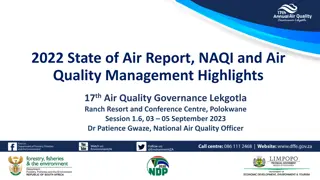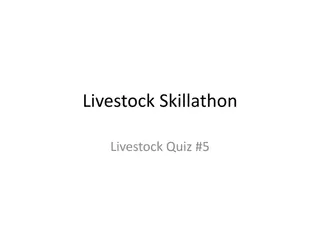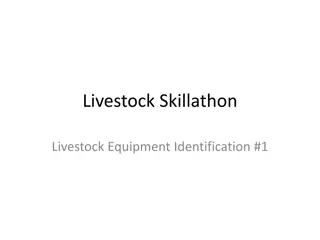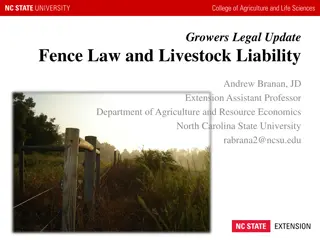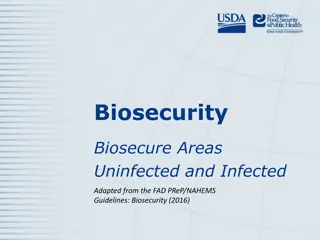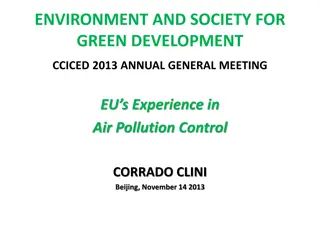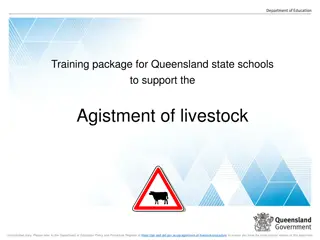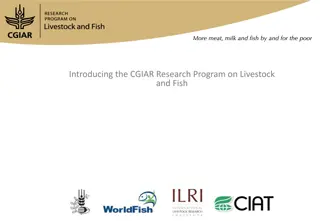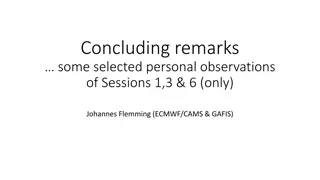Understanding Livestock Air Quality Management
Livestock air hygiene is crucial for animal welfare and production. Factors like emissions, pollutants, and ventilation impact air quality in confined feeding operations. Improving air quality benefits animals, workers, and the environment by reducing harmful emissions and enhancing productivity.
Download Presentation

Please find below an Image/Link to download the presentation.
The content on the website is provided AS IS for your information and personal use only. It may not be sold, licensed, or shared on other websites without obtaining consent from the author. Download presentation by click this link. If you encounter any issues during the download, it is possible that the publisher has removed the file from their server.
E N D
Presentation Transcript
ANIMAL AIR HYGIENE DR. S. P. SAHU Assistant Professor Livestock Production Management Bihar Veterinary College, Patna - 14
ANIMAL AIR HYGIENE Objectives: To know about air quality needed for livestock. To provide clean air for maximum production of livestock. Factors responsible for air pollution at livestock farm. Measures to control air pollution at livestock farm.
Animal Air Hygiene: Refers especially to emissions and other environmental problems (malodour, dust, airborne microbes) which derive from keeping animals in confinements as well as such which are caused by storage and utilization of animal residues (farmyard manure, urine, slurry).
Composition of Air By volume, dry air contains 78.09% nitrogen, 20.95% oxygen, 0.93% argon, 0.04% carbon dioxide, and 1% other gases and water vapour.
Air Quality Air quality is defined as the degree of pollution of clean air. Clean air is the air that is free from impurities. Air quality can be determined by measuring the concentration of pollutants in the air. The lower the concentration of airborne pollutants, the better is the air quality. Emission of pollutants is the release or discharge of a substance into the environment. Or to the release of gases or particulates into the air.
Air Quality Confined Feeding Operations (CFOs) can affect air quality through emissions of gases (ammonia and hydrogen sulfide), particulate matter, volatile organic and odour. Emissions from CFOs come from three primary sources: manure storage facilities, animal housing, and land application of manure. Emissions of pollutants depend on: temperature, humidity, ventilation rates, wind speed, ventilation rate, housing and manure management systems, and animal characteristics (species, size and density).
Benefits of improving livestock air quality Improves the health, welfare and production performance of the animals. Improves the health and safety of producers and workers. Reduces emissions of harmful pollutants to the outside environment. Results in significant energy and economic savings. Prolongs the life of building structures
Factors affecting livestock air quality (a) Weather: Air quality is getting worse during light wind conditions as pollutants cannot be blown away. A higher wind speed provides the pollutants with a greater air volume within which to disperse. (b) Livestock facilities and manure management: Building hygiene is one of the most important factors affecting air quality and livestock health. Adopting more innovative management systems is essential for improving air and surface hygiene in both new and existing livestock buildings.
Air Pollution Air pollution refers to the release of pollutants into the air that are detrimental to human and livestock health and the planet as a whole. Air pollution occurs when harmful or excessive quantities of substances are introduced into the atmosphere.
Factors affecting outdoor air Pollution Outdoor air pollutants mainly consist of NOx, SO2, O3, CO, HC and particulate matters of different particle sizes. Mainly emitted from on-road and off- road vehicles, power plants, industrial boilers, incinerators, petrochemical plants, aircrafts, ships etc. depending on the locations and prevailing winds. 1. Stationery and area sources An emission source that does not move. Stationary sources are defined as large emitters who release relatively consistent qualities and quantities of pollutants. The many smaller stationery sources located together whose individual emissions may be low but whose collective emissions can be hazardous.
2. Mobile sources A source that is capable of moving under its own power such as road transportation. Gas powered lawn tools and mowers, farm and construction equipments, recreational vehicles, boats, planes and trains. 3. Agricultural sources Animals also eliminate CO2, ammonia into the atmosphere The average figures for the hourly excretion of CO2 from animals: Lactating cow : 5 .8 cubic feet Horses : 3.9 cubic feet Swine : 1.3 cubic feet Sheep : 0.55 cubic feet
The misapplication of manures fertilizers, herbicides and pesticides can potentially result in aerial drift of these materials. 4. Natural sources An erupting volcano, Forest and prairie fires, Plants and tress emit hydrocarbons, Dust storms.
Factors affecting indoor air pollution A number of air pollutants have been recognized to exist indoors: NOx, SO2, O3, CO, volatile and semi-volatile organic compounds, PM, and microorganism. A lack of ventilation indoors concentrates air pollution. Building materials emit formaldehyde gas. Paint and solvents give off volatile organic compounds as they dry. Controlled wood fires add significant amounts of smoke particulates into the air.
Indoor pollution fatalities may be caused by using pesticides and other chemical sprays indoors without proper ventilation. Carbon monoxide poisoning and fatalities are often caused by faulty ventilation. The extensive use of asbestos causing asbestosis (chronic inflammatory condition of the lungs). Biological sources as animals hair, faeces, urine, mycotoxins, molds, lack of air circulation, ammonia etc.
Effects of air pollution on animals Reduce production efficiency and the general welfare of farm animals. Long term exposure also affect the respiratory health of farm workers. Suffocation, reproductive failure, damage veins of brains, Skin disease, chronic bronchitis, impaired lung function, Damages internal enzyme system, asthma, Disturbances in blood circulation, Tumor, Cough, Whooping cough.
Control of For Air Pollution Prevent agricultural residues burning. Reduce emissions through precision farming, and the use of urease inhibitors are on the mar ket. Proper manure disposal and its efficient uses. Use public mode of transportation to reduce pollution. Conserve electrical energy and fossil fuels.. Understand the concept of Reduce, Reuse and Recycle Emphasis on clean energy resources to curb air pollution. Use energy efficient devices to reduce pollution by consuming less energy. from mineral fertilizer application


